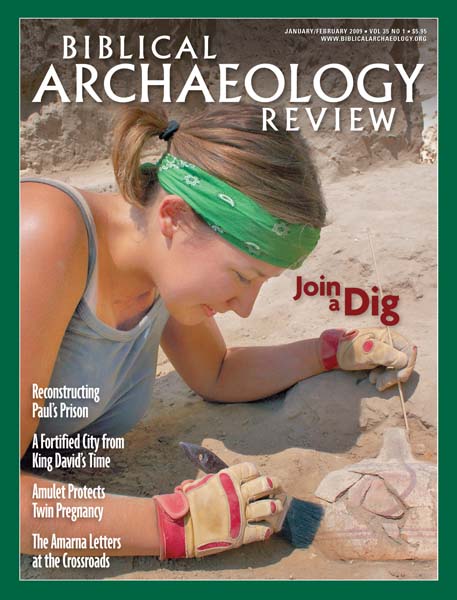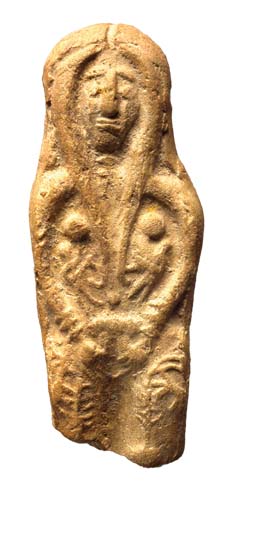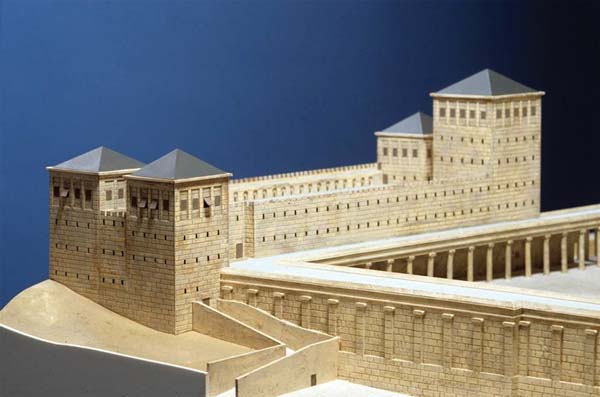
I’m writing to let you know my reason for not renewing my subscription. I do not like it when anyone tries to mess with the current Before Christ (B.C.), After Death (A.D.) time era(s) and tries to replace them with the Before Common Era (B.C.E.) and Common Era (C.E.).
Michael Sexton
La Mesa, California
Under Cover
Scantily clad maidens on the front cover again! (BAR 35:01).
Don’t you remember last time? Young ladies on desert digs should wear parkas and stay out of camera range. Or do you just like to tease the decency patrol?
Andrew Grygus
La Crescenta, California
Cover Girl Cover-Up
I suggest you get a long-sleeved shirt and straw hat for the blonde kid on the cover.
William G. Yungstrom
Brookings, Oregon

She Wouldn’t Know
It is very unlikely that the amulet mentioned in Tallay Ornan’s article, “Twins: A Dangerous Pregnancy” (BAR 35:01), would have been designed specifically for women pregnant with twins. Prior to ultrasound and stethoscopes, it’s unlikely that many ancient women bearing twins would be aware of the fact prior to the birth. Second, the two infants portrayed on the amulet are clearly not in the womb; they are reaching for the figure’s breasts in order to nurse.
Dick Boulton
Online Talkback
Anti-Twins Amulet
I seriously doubt that foreknowledge of a twin birth was possible in ancient times. Perhaps a better explanation for the amulet is that its purpose was to protect against having twins, and so prevent a dangerous birthing scenario.
James A. Harrell, Ph.D.
Professor of Archaeological Geology
Department of Environmental Sciences
University of Toledo
Toledo, Ohio
A Nursing Love Goddess
The figurine presented in “Twins: A Dangerous Pregnancy” is an image of the Canaanite love goddess, Asherah or Ashtoreth. She is in a very provocative pose. It brought to mind the Celtic “Sheela-na-Gig,” a female figure flagrantly displaying her sexual parts.
The usual images of Asherah show the goddess with her hands cupped under her breasts, enticing her devotees by displaying her charms and offering her life-giving milk. Here, however, the breasts are being suckled by two infants, and so the goddess offers her open-lipped genitalia instead.
That the image is of a fertility goddess is proven by the engravings of caprids and trees of life on her thighs, near her pubic area, which is also the source of life.
The figure does not represent a pregnant female, because it does not have the typical protruding belly or enlarged hips.
The idea that it would be an amulet used by women pregnant with twins, as proposed by the author, is unlikely because a woman in that time would not know whether she carried twins or not. Also the babies are shown lying upon the upper torso (above the navel) near the breasts, not in the area of the womb. And the idea that the female is opening her birth canal for easy delivery by simply pulling her labia apart is of no practical application. Her turned-up eyebrows are typical of many figurines of that time and do not show that she is in pain.
Richard L. Atkins
Winter Park, Florida
Tallay Ornan responds:
The possibility of a woman living in the premodern world sometimes anticipating a twin delivery is quite probable since the existence of twins in later phases of pregnancy is, at times, actually felt by the mother’s hand when rubbing her belly or can even be observed through the rounded contours of the two babies’ heads. These “signs” could have been understood by any woman who previously had a one-baby pregnancy or by an older female family member, not to mention by an experienced midwife. The fact that these observations could not be confirmed in antiquity made the need for amulets charged with the relevant powers even stronger.
Egyptian Sixes and Sevens
In the January/February issue Diana Gainer finds that six and seven are represented by similar words in many languages (Q&C, “At Sixes and Sevens”).
I also noticed this some years ago. My primary field of interest is Egyptology. In ancient Egyptian, six is ses and seven is sefekh.
There are other words that sound similar in many ancient languages, such as words for “Mother.” It’s mysterious, but that’s how I like it.
Bonnie Long
Phoenix, Arizona
Hungarian Sixes and Sevens
Diana Gainer comments on the similarity of the names of the numerals six and seven in several languages, including English, Latin and Greek, among many others. I may add to this list my native Hungarian in which six is written hat and seven is written hét. This is probably a coincidence though, as Hungarian is not even an Indo-European language, but rather belongs to the Finno-Ugric group that includes Finnish and Estonian besides Hungarian. I don’t speak either of the last two, but perhaps a reader who does could confirm (or deny) that in those also the six-seven similarity persists.
Andrew Lenard
Bloomington, Indiana.
Spanish Sixes and Sevens
Diana Gainer surmises that since there was such similarity in the numbers six and seven for such diverse peoples that there must have been an interaction at some point. I fully agree. One might add seis and siete, Spanish six and seven and the Italian and Portuguese equivalents to her list. This may be but one of quite a number of similarities between civilizations that popped up all over the globe at roughly the same time several thousand years ago.
Dale Carter
Fellsmere, Florida
Hershel Shanks asks for immediate release of an image of the Khirbet Qeiyafa ostracon (“Newly Discovered: A Fortified City from King David’s Time,” BAR 35:01). Shanks misses the point about how science works. He says, “Yossi [Garfinkel] stuck to the time-honored tradition that a readable picture of the inscription remain a secret until the scientific report is published.”
It is not a secret, kept hidden away for nefarious reasons. Yossi raised the money, did the excavation and sweated in the sun. He and his team deserve the opportunity to publish first. Why should somebody else profit before them on their work?
This is not at all analogous to the Dead Sea Scrolls, a situation in which people genuinely did not have access.
I am a physical scientist, and the data that comes from my lab gets published by me first. If others want to look at it, they can, but second. I once had a group at another institution ask me about making them a highly specialized optical component, which we were working on; I replied, “Yes, after we make it first and publish it.” In science, if you want to eat, you have to be at the kill.
In the interest of full disclosure, I know Dr. [Yossi] Garfinkel and worked on the imaging of the ostracon with a variety of techniques, both in Jerusalem and the United States.
Gregory Bearman, Ph.D.
President, Snapshot Spectra
Pasadena, California
Many Ancients Rose
My grasp of Hebrew is far too limited to judge between experts in a case like [the Dead Sea Scroll in stone] (Q&C, Israel Knohl’s response to “Simply Sign” BAR 35:01). But I know quite a lot about folklore. In the ancient Near East, there were many traditions, going back a long way, of someone who was beloved by a deity, who died and rose again. If there was someone who preceded Jesus and followed this tradition, written about in Hebrew, is this really so astonishing? Does this really change the history of Christianity? I think the answers are no and no. It is interesting? Yes. But we already knew about Dumuzi, Tammuz, Adonis, Ba’al, Attis, Osiris and who knows how many others. In ancient times, people believed these characters were real, they lived, they died, they rose again. But Jesus also taught people how to behave while they were here on earth, and I think that makes him a bit different.
Diana Gainer
Online Talkback
Scholars in Foxholes
Dr. Craig Evans is, of course, correct in his Biblical Views column (“Breaking the Trend of Biblical ‘Breaking News,’” BAR 35:01) [criticizing “sensational scholarship” that propounds “theories that may go well beyond the evidence—particularly in connection to Biblical figures”]. But this is a competitive world, and individual researchers seeking to rise in the esteem of their students, peers and employers (on the one hand), and (on the other hand) reporters, news “stringers” and sensationalist publishers all have free rein to publish any rubbish that may occur to them. Even in the “sober halls of academe,” “internationally known ‘scholars’” in well-respected institutions often remain entrenched in their own particular foxholes, with utter disdain for reasoned arguments.
John S. Holladay, Jr.
Professor Emeritus
Department of Middle Eastern Studies
University of Toronto
Toronto, Ontario, Canada
From Tiara to Trowel
It was good to read a First Person column from someone from a younger generation (Dorothy D. Resig, “
Tori Garrett
Edmond, Oklahoma
P.S. I had to use my mom’s e-mail account to send this since I can’t have my own yet. Moms are so unfair.
Looting Buddies
The idea of “competing” with the looters (Hershel Shanks, “A Radical Proposal,” BAR 34:06) strikes me as a very good idea for protecting antiquities from being lost to some drug dealer’s basement, while at the same time providing additional funding for archaeology. As Voltaire said, “perfect is the enemy of the good.” Unless the perfectionists can come up with a better method for preserving more antiquities, then your idea stands as the best available, and therefore should be pursued.
Don Hansen
Claremont, California
A Pagan Who Loves BAR
I am neither a Christian, Muslim nor Jew, although I have always been open to learning more about all the world’s religions. In fact, I am a devoted pagan. So it may come as some surprise that I have been reading every issue of BAR, cover to cover, for more than 15 years now. I read it because of the insights I gain into how interpreters of the archaeological record use ancient texts to help them understand the past (Nadav Na’aman, “The Trowel vs. the Text,” BAR 35:01). I read it because it keeps me up-to-date with the latest scientific tools being used by archaeologists and anthropologists. And I read it because it is one of the best magazines I know for providing a window into the sort of spirited debates that are the heartbeat of any scientific field. I realize that for many of your readers, BAR is all about their religion, but please know that for some it is all about the science.
Stephen Upjohn
San Francisco, California
BAR Strengthens Faith and Understanding
It is clear from even a cursory review of your journal that your aim is to provide scientific information about the history of the Biblical period. BAR has not ever been, and it should not seek to be, a religious philosophy magazine that bends archaeological findings toward one faith system or another. I find reading BAR strengthens my faith by enlightening me about the period in history when these momentous, revolutionary changes in our history took place.
Lynne Milford
Southlake, Texas
Uncover the Truth
As a Christian I would love nothing more than to see the Bible proved true through archaeology, but as an archaeologist I want to uncover the truth about history and find out what happened in our past. If one is to believe in a faith, one should be willing to study and look at all the aspects and if mistakes exist to correct them or find out why. While the Bible is the Word of God, the Word was written down by human hands, and humans can make mistakes.
John T. Muraski
University of Minnesota
Minneapolis, Minnesota
In “High Priest Inscription Found in Jerusalem” (Strata, BAR 35:01), Dorothy Resig talks about the high priest’s duties on Yom Kippur. She states, “It was seen as such a dangerous task that the high priest wore chimes on his garments so the other priests could hear him moving around and know he was still alive.”
However, in Leviticus 16:3–4 we read, “This is how Aaron is to enter the sanctuary area: with a young bull for a sin offering and a ram for a burnt offering. He is to put on the sacred linen tunic, with linen undergarments next to his body; he is to tie the linen sash around him and put on the linen turban. These are sacred garments; so he must bathe himself with water before he puts them on.”
This is at the beginning of the instructions for Yom Kippur ceremonies. In other words, there’s a high probability that he wouldn’t be wearing the outer garment with the chimes on the hem. On that day he would be dressed as an ordinary priest.
David Snoek
Hudsonville, Michigan
You’re right, but Exodus 28:34–35 states that Aaron would wear the outer garment “when he ministers, and its sound shall be heard when he goes into the holy place before the Lord, and when he comes out, so that he may not die.”—Ed.
Your reporting of current news in Biblical archaeology is very timely and interesting; it is a bit like candy for the academic.
Melissa J. Standley
Assistant Professor of English
University of Maine at Fort Kent
Fort Kent, Maine



